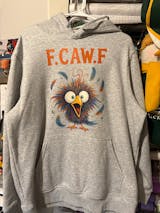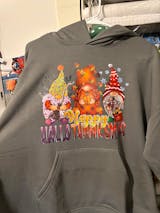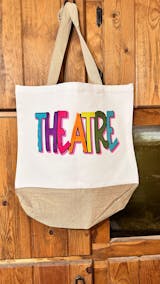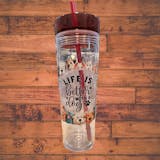If you're an avid crafter and own a Cricut heat press , then you know the thrill of creating personalized designs on your favorite clothing items. But have you ever wondered how to take your creations to the next level? Look no further than DTF transfers. DTF, or Direct-to-Film, transfers are a game-changer in the world of heat press printing. In this article, we'll guide you through the process of mastering DTF transfers with your Cricut heat press, allowing you to produce professional-quality prints that are sure to impress.
With easy-to-follow steps and tips, we'll walk you through each stage of the process, from selecting the right DTF transfer film to preparing your design, and finally, pressing it onto your garment. Whether you're a seasoned heat press pro or a beginner looking to expand your skills, our comprehensive guide will equip you with all the knowledge you need to achieve flawless DTF transfers every time.
So, grab your Cricut heat press and get ready to take your creations to a whole new level with DTF transfers. Get ready to leave your mark in style!
Understanding the Basics of DTF Transfers
DTF, or Direct-to-Film, transfers represent a revolutionary advancement in the realm of garment printing. Unlike traditional methods that often require extensive preparatory steps or specialized equipment, DTF allows for a more streamlined approach to creating vibrant designs. The process involves printing a design onto a special film, which is then transferred onto the fabric using heat and pressure. This method has gained popularity due to its versatility, enabling crafters to print on various materials including cotton, polyester, and blends, making it a go-to choice for many.
What sets DTF apart from other printing techniques is its capability to produce intricate designs with rich colors and smooth gradients. The technology utilizes a unique type of ink that adheres well to the film and fabric, ensuring that the final print is not only visually appealing but also durable. The resulting transfers are known for their softness, meaning they do not feel heavy or plasticky on the garment, a common complaint with some heat transfer vinyls. This aspect is particularly important for those who prioritize comfort and wearability.
Another key advantage of DTF transfers is the ability to print white ink, which is essential for designs on dark fabrics. This allows for greater flexibility in design choices, enabling creators to explore a wider range of color combinations and artistic expressions. Understanding these fundamentals will prepare you to delve deeper into the world of DTF transfers, equipping you with the knowledge to create stunning, professional-quality prints using your Cricut heat press.
Choosing the Right Materials for DTF Transfers
To successfully execute DTF transfers, selecting the right materials is crucial. The primary components you will need include DTF transfer film, the appropriate ink, and adhesive powder. The transfer film is specifically designed for DTF printing, with a special coating that allows the ink to adhere properly. When purchasing this film, ensure that it is compatible with your printer, as there are variations available on the market.
The ink used in DTF printing is typically a specialized water-based ink that is designed for use with DTF printers. This ink not only provides vibrant colors but also has excellent wash and wear durability. It's essential to choose high-quality inks to achieve the best results. You may also encounter pigment inks, which can be suitable for DTF transfers, but ensure they are compatible with your film and adhesive powder.
Adhesive powder is the final key material necessary for DTF transfers. After printing your design on the transfer film, the adhesive powder is sprinkled over the wet ink. This powder helps the print adhere to the fabric when heat is applied. There are various types of adhesive powders available, and choosing a high-quality product will help ensure a strong bond between your design and the garment. At We Print U Press, we invest in KODAK brand powder because we know they have high standards and the powder is one of the most critical components to high quality, soft feel DTF transfers.
Preparing Your Artwork for DTF Transfers
Once you've gathered your materials, the next step is to prepare your artwork for DTF transfers. This stage is critical, as the quality of your design will ultimately affect the final outcome. Begin by choosing a high-resolution image that suits your project. The resolution is important because a low-resolution image can result in pixelation and a less-than-professional appearance. Aim for a resolution of at least 300 DPI (dots per inch) for the best results.
After selecting your image, you'll need to adjust the colors and ensure that it fits the dimensions of the transfer film. This can be done using graphic design software such as Adobe Illustrator, Photoshop, or even Cricut Design Space. When working in these programs, remember to use layers, as this will allow you to manipulate different aspects of your design separately. You can also add text or other elements to enhance your creation, but be mindful of spacing and alignment to ensure a balanced look.
Lastly, prepare the file for printing by converting it to a format that is compatible with your printer. Common file types for DTF printing include PNG, JPG, and TIFF. Ensure that you mirror your image before printing, especially if it includes text or intricate designs. Mirroring will ensure that the design appears correctly when transferred onto the fabric. With your artwork ready, you are set to print and transfer your design onto your chosen garment.
As an alternative, you can upload your custom design right to our fast, easy to use gang sheet auto builder and leave the DTF printing to We Print U Press!
Setting Up Your Cricut Heat Press for DTF Transfers
Before you can start pressing your DTF transfers, it's essential to set up your Cricut heat press correctly. Begin by ensuring that your heat press is clean and free of any debris or residues from previous projects. A clean pressing surface will help prevent any unwanted marks on your garment. Next, plug in your heat press and set it to the appropriate temperature for DTF transfers, typically around 300°F to 320°F (160°C to 165°C).
While the heat press is warming up, prepare your workspace. Lay out your garment on a flat, heat-resistant surface, and ensure it is free of wrinkles. You can use a lint roller to remove any lint or particles that may interfere with the adhesion of the transfer. It's also a good idea to pre-press the garment for about 5-10 seconds. This step helps eliminate any moisture and ensures a smooth surface for your DTF transfer, contributing to a better final result.
Once your heat press has reached the desired temperature, you are ready for the pressing process. Make sure to set the timer according to the manufacturer's instructions, typically between 10-20 seconds, depending on the specific materials and the thickness of the fabric. Familiarize yourself with your Cricut heat press settings and operation to ensure a seamless transfer process. With everything in place, you can confidently move to the next stage of applying your DTF transfers.
Step-by-Step Guide to Applying DTF Transfers with Your Cricut Heat Press
Now that your artwork is prepared and your heat press is set up, it’s time to apply your DTF transfer. Begin by positioning the printed transfer film onto your garment. Ensure the design is centered and straight to achieve a professional look.
With everything in place, apply firm pressure. The heat and pressure will activate the adhesive in the transfer, bonding it to the fabric. Keep an eye on the timer, and once it goes off, carefully lift the heat press. It's vital to allow the transfer to cool completely before peeling off the film. This cooling period allows the adhesive to set properly, resulting in a more durable bond. Also, ensure that you applied heavy pressure while pressing the garment. This is critical for DTF transfer success.
After peeling the film away, cover them again with a protective sheet (parchment paper, teflon sheet or T Seal and press for an additional 20 seconds. Once satisfied with the adhesion, allow the garment to cool completely before handling it.
Troubleshooting Common Issues with DTF Transfers
Even with careful preparation, you may encounter some challenges when working with DTF transfers. One common issue is incomplete adhesion, where parts of the design do not stick to the fabric. This can occur due to insufficient heat, pressure, or time during the pressing process. To remedy this, ensure that your heat press is properly calibrated and that you are using the correct settings for the materials you are working with. If you find that some areas are lifting, you can re-press those sections with additional heat and pressure.
Another issue is color fading or dullness after washing. This can be frustrating, especially when you have put effort into creating a vibrant design. To prevent this, always use high-quality inks and ensure that the adhesive powder is evenly applied to the printed design before pressing. Additionally, following proper washing instructions, such as turning the garment inside out and using cold water, can help maintain the vibrancy of your DTF designs.
Lastly, if you notice that the print has a rough or uneven texture, it may be due to incorrect pressure settings on your heat press. Adjusting the pressure to be firmer can result in a smoother finish. It’s also a good idea to regularly check the condition of your heat press pads and ensure they are in good shape, as worn pads can lead to uneven pressure distribution. By addressing these common issues, you can improve your DTF transfer results and achieve a polished, professional look.
Tips and Tricks for Achieving Professional Results with DTF Transfers
To elevate your DTF transfer skills, consider implementing some tried-and-true tips and tricks that can make a significant difference in your final results. First, always test your materials and settings with a sample piece before committing to a larger project. This practice allows you to fine-tune your heat and pressure settings, ensuring that you achieve the best possible outcome without risking your main garment.
Additionally, experimenting with different fabrics can yield exciting results. While cotton and polyester blends are the most commonly used materials for DTF transfers, trying out unique fabrics can add variety to your projects. Just remember to adjust your heat press settings accordingly, as different materials may require slight modifications in temperature and time for optimal adhesion.
Lastly, don't underestimate the power of creativity in your designs. Consider layering multiple colors and textures to create eye-catching, custom pieces. Combining DTF transfers with other techniques, such as sublimation or vinyl, can lead to truly unique creations. The more you practice and experiment, the more proficiency you will gain, leading to professional-quality results that showcase your personal style.
Taking Your DTF Transfers to the Next Level with Advanced Techniques
Consider creating custom cut shapes or designs that can be used alongside your DTF transfers. By integrating cut vinyl or other materials into your projects, you can enhance the overall aesthetic and create truly one-of-a-kind pieces. This approach not only showcases your creativity but also allows for greater flexibility in design. Embracing these advanced techniques will empower you to take your DTF transfers to the next level and impress anyone who sees your work.
Conclusion and Final Thoughts on Mastering DTF Transfers with Your Cricut Heat Press
In conclusion, mastering DTF transfers with your Cricut heat press opens up a world of creative possibilities for crafters and designers alike. By understanding the basics of DTF printing, selecting the right materials, and preparing your artwork effectively, you set a solid foundation for achieving stunning results. The pressing process, although straightforward, requires careful attention to detail to ensure that your designs adhere flawlessly to your chosen garments.
As you continue to practice and experiment with DTF transfers, remember that troubleshooting common issues is part of the learning curve. Embracing this journey will not only enhance your skills but also boost your confidence as a creator. Incorporating tips and tricks along the way can further refine your techniques, allowing you to produce professional-quality prints that reflect your unique style.
Finally, as you explore advanced techniques and push the boundaries of your creativity, the potential of DTF transfers becomes even more apparent. Whether you're creating custom apparel for personal use, gifts, or even starting a small business, the possibilities are endless. So, gather your materials, set up your Cricut heat press, and dive into the exciting world of DTF transfers—your next masterpiece awaits!











